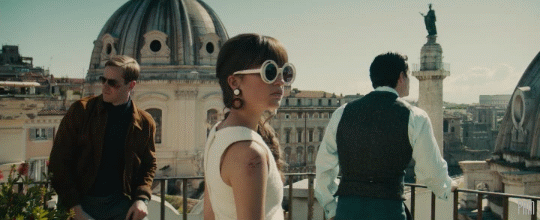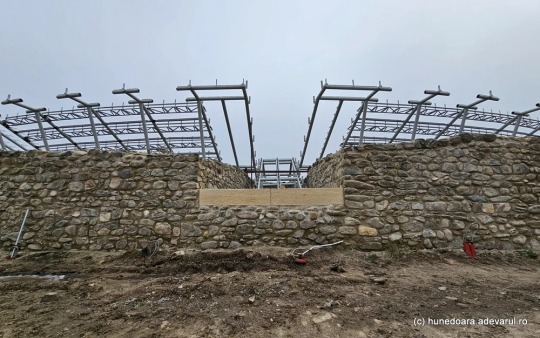#traiana
Photo




The Man From U.N.C.L.E. (2015)
#2015#gif#film#movie#The Man From U.N.C.L.E.#Guy Ritchie#Armie Hammer#Illya Kuryakin#Alicia Vikander#Gaby Teller#Henry Cavill#Napoleon Solo#Hugh Grant#Waverly#Elizabeth Debicki#Victoria Vinciguerra#KGB#CIA#Palazzo delle Assicurazioni Generali#Colonna Traiana#Trajan's Column#Piazza Venezia#Rome#Italy#spy
66 notes
·
View notes
Text

colonna traiana, Roma, 2023
#roma#rome#italy#italia photo mratahon#art and architecture#urban exploration#street photography#piazza venezia#original photographers#lensbr#lensbrnetwork#lensculture#nikon#nikon d90#colonna traiana
5 notes
·
View notes
Text
An old tavern on the Rhine.
An old tavern on the Rhine - a visit to Xanten Archaeological Museum.
#ancientrome #rome #archaeology #coloniaulpiatraiana #romanempire

View On WordPress
1 note
·
View note
Text

Recreació de Colonia Ulpia Traiana (Colònia Úlpia Trajana), ciutat romana pròxima a l'actual Xanten, vora el Rin.
1 note
·
View note
Text
Roma / Convegno: “La fortuna della Colonna Traiana. Il racconto di un simbolo”
Roma / Convegno: “La fortuna della Colonna Traiana. Il racconto di un simbolo”
Appuntamento il 22 e 23 aprile in Curia Iulia nel Foro Romano
In occasione del finissage della mostra “La Colonna Traiana. Il racconto di un simbolo” il Parco archeologico del Colosseo promuove e organizza nella Curia Iulia nel Foro Romano nei giorni 22 e 23 aprile un convegno internazionale di studi a cura di Alfonsina Russo, Federica Rinaldi, Angelica Pujia e Giovanni Di Pasquale.
Il convegno – dal titolo “La fortuna della Colonna Traiana. Il racconto di…

View On WordPress
#Alfonsina Russo#Angelica Pujia#antica roma#Colonna Traiana#convegni#eventi#Federica Rinaldi#Giovanni Di Pasquale#Parco Archeologico del Colosseo#Roma#Roma antica
0 notes
Text
Amfiteatrul din Ulpia Traiana Sarmizegetusa, „restaurat” cu tribune metalice
Lucrările de restaurare care cuprind Amfiteatrul din Ulpia Traiana Sarmizegetusa se apropie de final, dar proiectul are șanse minime de a fi realizat în termenul prevăzut, decembrie 2023. Monumentul antic este dotat în aceste zile cu tribune metalice.
Turiștii care vizitează Ulpia Traiana Sarmizegetusa, rămășițele primului oraș antic înființat de romani pe teritoriul Daciei, aflate în județul…

View On WordPress
#amfiteatru sarmizegetusa#dacia romana#HUNEDOARA#imparatul traian#imperiul roman#restaurare sarmizegetusa#roma antica#stiri din galati#stiri galati#tribune metalice#ulpia traiana sarmizegetusa
1 note
·
View note
Text
Colonna Traiana: il mio progetto per la sistemazione dell'area
Sapete che mi feci carico di sistemare l’area adiacente alla Colonna Traiana?
Ebbene sì, è una di quelle storie poco note che oggi ho proprio voglia di raccontarvi. Mi siedo comodo e inizio a narrarvi pure questa vicenda mentre la gatta mi s’è accovacciata sulle gambe e ronfa che è una meraviglia.
Scartabellando fra gli atti scritti durante la riunione del Consiglio comunale di Roma che si…

View On WordPress
#antonietta bandelloni#art#artblogger#arte#artepertutti#artinfluencer#bellezza#colonna traiana#considerazioni#english#masterpiece#Michelangelo Buonarroti#rinascimento#Roma#Rome#scultura
1 note
·
View note
Text

traiana7: Nida in Lake Tahoe, 2019 ✨🏞️🎞️
0 notes
Text
Coin of the Day #3 (5/7/2024)
How about a legionary issue for the day of Mars?


Roman Province - Egypt
BI/Potin Tetradrachm - 20mm 7.36g
Numerian 284 AD
Alexandria Mint
Obverse A K M A NOYMEPIANOC CEB
Bust of Numerian right, laureate, draped, cuirassed
Reverse ΛΕΓ Β ΤΡΑΙ LΓ
Eagle standing left, head right, wreath in beak (Legio II Traiana issue)
RPC X 75876
#Coin of the Day#Roman Empire#Roman Province#Numerian#Ancient Rome#Ancient Egypt#Alexandria#Roman coins#Egyptian coins#coin#coins#numismatics#ancient coins
4 notes
·
View notes
Photo

A very young Romania and Moldova from Hetalia with their mother, Dacia, and their sister Transylvania. APH Romania and Moldova belong to Hidekaz Himaruya.
Dacia (Dacia Traiana) is one of the bastard children of Roman Empire. Her mother, the Getae tribe, was conquered and little Dacia was born. Some in Rome's household suspected Dacia wasn't actually his, as she did not have the signature hair-curl that Rome's descendants inherit, but she did have gold-amber eyes that were very much like her father's and that was all the proof Rome needed. She was a willful and wild child growing up, and loved the woods and hunting. She was so talented at archery at such a young age that Rome gave her the human name "Diana." Rome also used to call his daughter his "little wolf pup" as Dacia had a special bond with wolves. When the empire began to show cracks in its stability, Dacia and her mother were largely left to their own devices in their homeland, as Rome was too preoccupied to really notice them leaving. He did try to find them again, but was ultimately forced to abandon them to the wilderness. Dacia, no longer under her father's protection, had to face invasions from Goth, Hun, Gepid, Avar, and Bulgar. During this period, Dacia gave birth to three children; her eldest son Wallachia (later Romania), her daughter Transylvania, and her youngest son Moldavia (later Moldova). It is unclear who the father of Dacia's children was, but it was most likely Goth.
The family got to spend quite a few happy years, together, despite the constant invasions and their eventual subjugation under the Bulgarian Empire. Dacia taught her children the folk magic she learned from her mother and would tell them dark stories of the monsters that lurked in the woods. They mostly lived in mountain villages for safety from raids, but were sometimes forced to flee when locals suspected they weren't human. Dacia also told her children that they were of noble blood, being direct descendants of Rome, himself, and that they should not allow themselves to be humbled by other nations.
Dacia had, for a time, hoped that they would eventually be able to become subjects of her half-brother, Byzantine Empire, but he, like Rome before him, had no choice but to forfeit his claims to sovereignty over Dacian lands. Young Romania deeply resented being subject to anyone and was constantly talking back to Bulgaria and trying to assert his independence. Transylvania tried to mediate some of the problems, but Romania only got angry when he saw how close she was getting with Hungary, whom Romania hated from the first moment they met. Romania and Hungary would continue to fight for centuries over Transylvania. Hungary once had to ask Prussia (who was still Teutonic Knights, at the time) to look after Transylvania, but then had to kick his butt when he tried to make Transylvania one of his subjects.
Little Moldova managed to fend for himself for a while, living as a principality and successfully fighting against Poland, Hungary, and even Ottoman Empire. From childhood, though, he was very small in stature and almost feral in nature. He was constantly getting into scrapes and ripping his clothes when he was very little, leading his mother to have to patch them up all the time. After Dacia died, Moldova only had Romania and Transylvania to look to for guidance, and all three eventually were reunited after they were conquered by the Ottoman Empire. The family would be separated again, though, when Moldova was taken over by Russia while Romania and Transylvania were taken away by Hungary.
Romania became very resentful of the Great Powers of Europe, especially in the 1800s. He worked tirelessly to try and reunite his family and gain independence. Despite numerous setbacks and failures, he still persevered. Though Romania, Transylvania, and Moldova were pulled apart, time and time again, they still found their way back to each other. Even when Moldova became his own country and Transylvania insisted on keeping to some of the customs she learned from Hungary, the bond between the three siblings remains strong even into the present.
#Axis Powers Hetalia#hetalia#historical hetalia#aph romania#hetalia romania#aph moldova#hetalia moldova#hetalia oc#hetalia fanart#aph transylvania#aph dacia#redbayly
19 notes
·
View notes
Text
Btw last night my dream was a mix between Snowpiercer, Toy Story 3 and one of those old silent movies about Old Wild West set on trains. I think it was a critique against capitalism and children playing with technologies more than actual toys. Abed Nadir was there and played scrabble. And the key to it all was the Trajan's Column (yes, la Colonna Traiana) held in a room protected with lasers. Oh and Lance Stroll was there and asked me to marry him and I said no and he sent guards to hunt me on the train.
#this is very funny for a number of reason#of course in my anti-capitalist dream Lance Stroll is there#I don't even dislike him I just don't think of him a lot. Why was he there IN ASTON MARTIN POLO AND WHITE SHORTS-#probably should have married him. He's very rich. and could introduce me to Fernando Alonso.#also there was a train that went to Napoli Afragola to United States of America. Like#it was the next stop after Napoli Afragola. Just United States of America. Not a city. Just the USA.
1 note
·
View note
Link
0 notes
Text
Events 6.24 (before 1900)
1312 BC – Mursili II launches a campaign against the Kingdom of Azzi-Hayasa.
109 – Roman emperor Trajan inaugurates the Aqua Traiana, an aqueduct that channels water from Lake Bracciano, 40 kilometres (25 miles) northwest of Rome.
474 – Julius Nepos forces Roman usurper Glycerius to abdicate the throne and proclaims himself Emperor of the Western Roman Empire.
637 – The Battle of Moira is fought between the High King of Ireland and the Kings of Ulster and Dál Riata. It is claimed to be the largest battle in the history of Ireland.
843 – The Vikings sack the French city of Nantes.
972 – Battle of Cedynia, the first documented victory of Polish forces, takes place.
1128 – Battle of São Mamede, near Guimarães: Forces led by Afonso I defeat forces led by his mother Teresa of León and her lover Fernando Pérez de Traba.
1230 – The Siege of Jaén begins, in the context of the Spanish Reconquista.
1314 – First War of Scottish Independence: The Battle of Bannockburn concludes with a decisive victory by Scottish forces led by Robert the Bruce.
1340 – Hundred Years' War: Battle of Sluys: The French fleet is almost completely destroyed by the English fleet commanded in person by King Edward III.
1374 – A sudden outbreak of St. John's Dance causes people in the streets of Aachen, Germany, to experience hallucinations and begin to jump and twitch uncontrollably until they collapse from exhaustion.
1497 – John Cabot lands in North America at Newfoundland leading the first European exploration of the region since the Vikings.
1509 – Henry VIII and Catherine of Aragon are crowned King and Queen of England.
1535 – The Anabaptist state of Münster is conquered and disbanded.
1540 – English King Henry VIII commands his fourth wife, Anne of Cleves, to leave the court.[
1571 – Miguel López de Legazpi founds Manila, the capital of the Philippines.
1593 – The Dutch city of Geertruidenberg held by the Spanish, capitulates to a besieging Dutch and English army led by Maurice of Nassau.
1604 – Samuel de Champlain encounters the mouth of the Saint John River, site of Reversing Falls and the present-day city of Saint John, New Brunswick, Canada.
1622 – Battle of Macau: The Dutch make a failed attempt to capture Macau.
1663 – The Spanish garrison of Évora capitulates, following the Portuguese victory at the Battle of Ameixial.
1717 – The Premier Grand Lodge of England is founded in London, the first Masonic Grand Lodge in the world (now the United Grand Lodge of England).
1724 – On the Feast of St. John the Baptist, Bach leads the first performance of his Christ unser Herr zum Jordan kam, BWV 7, the third cantata of his chorale cantata cycle.
1762 – Battle of Wilhelmsthal: The British-Hanoverian army of Ferdinand of Brunswick defeats French forces in Westphalia.
1779 – American Revolutionary War: The Great Siege of Gibraltar begins.
1793 – The first Republican constitution in France is adopted.
1812 – Napoleonic Wars: Napoleon's Grande Armée crosses the Neman river beginning the invasion of Russia.
1813 – Battle of Beaver Dams: A British and Indian combined force defeats the United States Army.
1821 – Battle of Carabobo: Decisive battle in the war of independence of Venezuela from Spain.
1859 – Battle of Solferino (Battle of the Three Sovereigns): Sardinia and France defeat Austria in Solferino, northern Italy.
1866 – Battle of Custoza: An Austrian army defeats the Italian army during the Austro-Prussian War.
1880 – First performance of O Canada at the Congrès national des Canadiens-Français. The song would later become the national anthem of Canada.
0 notes
Photo

Strade Romane
Finalmente è fatto. Un diagramma in stile metropolitano delle principali strade romane, basato sull'Impero di ca. 125 d.C.
La creazione di questo ha richiesto molte più ricerche di quanto mi aspettassi: non esiste un’unica fonte coerente che fosse particolarmente utile per questo. Un enorme ringraziamento a: il modello ORBIS di Stanford , il progetto Pelagios e l'itinerario antonino (trovato un PDF completo online ma perso l'URL).
Le linee sono una combinazione di strade reali con nome (come la Via Appia o la Via Militaris) e di strade che non hanno un nome storico noto (nel qual caso ho inventato creativamente alcuni nomi). Passa alla sezione "Libertà creative prese" per i dettagli.
Quanto tempo occorrerebbe effettivamente per percorrere questa rete? Dipende molto dal mezzo di trasporto che usi, che dipende da quanti soldi hai. Un altro fattore importante è la stagione: ogni periodo dell’anno pone le proprie sfide. In estate ci vorrebbero circa due mesi per camminare a piedi da Roma a Bisanzio. Se avessi un cavallo, ti ci vorrebbe solo un mese.
Tuttavia, nessun romano sano di mente utilizzerebbe solo le strade dove è possibile viaggiare via mare. La navigazione a vela era molto più economica e veloce: una combinazione di cavallo e barca a vela ti avrebbe portato da Roma a Bisanzio in circa 25 giorni, da Roma a Cartagine in 4-5 giorni. Dai un'occhiata a ORBIS se vuoi giocare con una "Google Maps" per l'Antica Roma. Per semplicità ho deciso di non includere le rotte marittime sulla mappa.
Libertà creative prese
L’elemento creativo più importante è stato scegliere quali strade e città includere e quali escludere. Non potrei includere tutte le strade romane, queste sono solo le principali. Ho cercato di includere le città con una popolazione più numerosa o le città che erano capoluoghi di provincia intorno al II secolo.
Ovviamente per viaggiare da Petra a Gaza si prenderebbe una strada più o meno diretta, anziché andare a Damasco e “trasferirsi” sulla Via Maris. Il modo in cui viaggiamo su strada è molto diverso da quello su rotaia, il che rappresenta un piccolo difetto nel concetto della mappa. Ma penso che sia comunque esteticamente gradevole e informativo.
Ecco un elenco delle strade che hanno nomi e percorsi autentici:
Via Appia
Via Augusta
Via Aurelia
Via Delapidata
Via Domizia
Via Egnazia
Via Flaminia
Via Flavia (I, II, III)
Via Giulia Augusta
Via Lusitanorum
Via Militaris
Via Popilia
Via Portumia
Via Salaria
Via Tiburtina
Via Traiana
Via Traiana Nova
Alcune strade hanno nomi reali ma sono stati leggermente modificati:
La Via Latina I si univa alla Via Popilia. In realtà la Popilia finiva a Capua, e la Latina andava da Capua a Roma.
La via Aquitania si riferiva solo alla strada da Burdigala (Bordeaux) a Narbo (Narbonne).
Allo stesso modo, Via Asturica Burdigalam si riferisce solo al tratto Astrurica-Burdigala.
“Via Claudia” non è un nome vero e proprio, ma si riferisce ad una vera e propria strada continua costruita da Claudio.
La Via Adriana era una vera e propria strada in Egitto, ma si riferisce ad un tratto leggermente diverso rispetto alla via verde.
Il nome “Via Maris” è considerato una creazione moderna, riferendosi ad un'antica strada commerciale il cui vero nome è andato perduto nella storia.
Via Valeria si riferiva solo ad un tratto dell'anello giallo siciliano.
Le strade intorno a Pisae, Luna e Genua avevano diversi nomi per diversi tratti, tra cui Via Aemilia Scauri . A volte “Via Aurelia” si riferiva all'intera strada da Roma ad Arelate.
Via Sucinaria è il nome latino della Via dell'Ambra, una via commerciale dalla regione baltica all'Italia che trasportava l'ambra come bene prezioso. Probabilmente non era usato per riferirsi ad una singola strada letterale.
Via Gemina e Via Claudia Augusta sono nomi veri e propri che si riferivano a piccole parti dei percorsi segnati sulla mappa.
Le altre strade hanno nomi relativamente poco creativi che ho inventato io, di solito basati sul luogo che attraversano. Non ho mai studiato formalmente il latino e ammetto che sono un po' confuso dalla distinzione tra le desinenze -a e -ensis , quindi c'è una possibilità che io abbia sbagliato tutto.
(via Strade romane | Sasha Trubetskoy)
1 note
·
View note
